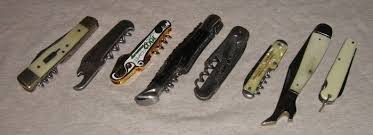
Bartender knives and a few related patterns.
This page offers some basic background information on bartender knives. I am in no way an expert on the development of the various patterns. In fact, I barely know anything about them, except that I like them and I know one when I see it. For the most part, I do not who designed the various patterns. The page discusses what I know and what I assume about the pattern, As I learn more and am corrected, I will update this page.
 Bartender knives and a few related patterns. |
The Bartender knife is a pocket tool that has been around for over 100 years. In that time the principle blades have changed very little. For the most part, the spear blade and cork screw are two constants found on all bartender knives. Additional tools that are sometimes found include: cap lifter (bottle opener), pen blade, and label cutter. For the last several decades, the bartender knife has fallen from favor and is being replaced by the bartender tool (also known as the waiter’s friend). The bartender tool is a basically a corkscrew with a cap lifter on one end and a small folding pen blade on the other.
I think a misconception of this knife is that it was widely used by bartenders. More likely, most of the knives were given away or sold for a small fee as promotional or advertising knives. A well stocked bar has better corkscrews, and other instruments to fill the needs of what these knives can be used for. At best they may have been a handy back up tool.
| Some Common Bartenders | |
|
A B-13 corkscrew/caplifter and good quality Bulgarian bartender knife using the same pattern. This is is probably one of the most common patterns. Ideal of USA made poor quality knives and sold them as souvenir trinkets. They are fond all over eBay and sold at for outrageous prices. The knife say Wine in Bulgarian on the Scale. The B-13 is a "Nifty". A common pattern from Chicago, Illinois. |
A Becker Bartender knife with the lever to make pulling the cork easier. The lever also doubles as a caplifter. These were precursors to the modern Bartender tool. The knife is advertising Cook's Imperial Champagne.
|
I’m not certain when the first bartender knife was made but for the sake of argument I will go out on a limb and say their popularity exploded around 1897. It was in this year, that Adolph Kastor patented his new corkscrew knife. Today, the basic design is often called a Stanhope knife. (Stanhope refers to an equally interesting magnifying peep window that was placed in a knife handle or other object that allowed for a tiny photograph to be viewed when one “peeped” through the window.)
These early knives featured a rather fancy handle with a spear- master and pen secondary at the top of the knife and label cutter on the opposite end. The newly patented corkscrew was mounted on the spine. The Stanhope lens allowed the knife to be a novel way of advertising which made the knives extremely popular. Among Adolph Kastor’s most prominent customers was Adolphus Busch of Anheuser-Busch fame. Busch would give the Stanhope knives to tavern owners who agreed to sell his beer. The little Budweiser knives were given out by the thousands. While the crown cork had been invented many years earlier, the use of such bottled beverages in American Taverns was virtually non-existent; meaning the need for a cap lifter on the bartender knife was not seen as essential. The little label cutting blade, essentially a small hawkbill proved to be ideal, however for quickly cutting through wax seals, or other difficult seals placed on bottles. The cork screw, obviously, was a god-send.
|
|
Gentleman's knives were and are popular as Bartenders. Indeed many of the early knives were nothing but a equal-end penknife with an added corkscrew. The knife on the left is a small jack knife with scissors, corkscrew and small pick (used for pipe cleaning) |
Now obviously most tavern owners had better corkscrews and label cutters, but the little knife was compact and handy. The knives were also handy for picnicking and camping trips, especially during the turn of the 20th century when Americans fell in love with the car. During this time it was common for car owners to pack up the kitchen and spend the week-end in the country or on the sea-shore. A combination tool such as a bartender’s knife was perfect for such occasions.
Indeed two knives that were nothing more than modified large frame toothpicks, the Laguiole pocket knives and the Lady’s Leg knife, were ideal knives for such occasions. The Laguiole with the spine mounted corkscrews were even known as picnic knives. The blade was used to cut sausage, cheese and bread and the corkscrew was there for the bottle of wine. The lady’s leg knife was similar except the boot on the knife is there to remove the “crown cork” or bottle cap from a beer instead of pulling a cork from a wine bottle. (One has to wonder why no one ever got around to adding a corkscrew to a lady’s leg knife!) Today, everything from fish knives, to Swiss Army Knives continue to incorporate many of the tools used to open a bottle of wine, beer or other alcoholic spirits.
As time marched on, other styles of bartender knives were developed. Many of the later models incorporated a cap lifter. In some cases the cap lifter was integrated into the main spear. Other times the cap lifter was a secondary blade or was integrated somehow into the handle. Other blades that have been included are can openers and cigar cutters. Around 2003, W.R. Case & Son modified its pattern 130 gunstock jack knife by adding a label cutting blade and cork screw creating their version of the bartender knife.
Some companies that currently offer a bartender style knife are:
|
Victorinox offers a “waiters knife.” The knife is single layer 84 mm pattern with a main spear, cap lifter/screwdriver, and spine mounted corkscrew. It also has the toothpick and tweezers in the scales. This is probably the most affordable and of the bartender knives also offers the most versatility due to the inclusion of a cap lifter. (Obviously, any Swiss Army knife with a cap lifter and corkscrew could perform as a bartender, knife. The Waiter is the only one designed specifically for the task) As this is a Victorinox knife, the tweezers and toothpick are included. |
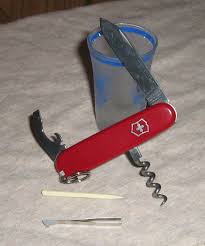 |
|
Hen & Rooster offer a reproduction of the old Stanhope style knives. The pattern was released a 100th anniversary of the Boy Scouts of America as well as 160th anniversary of Hen & Rooster. The knife is a bit pricey for the quality and was meant as collectors piece not for actual use. Both knives feature painted white enamel on a brass finish. The BSA has a small picture of the Boy Scout founder in the viewer. The 160th has the H&R logo in the viewer. |
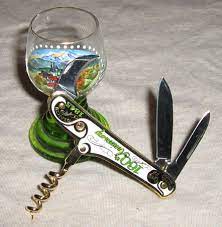 |
| U.S. Classic offered a copy of the W.R. Case & Son knife. The company is defunct as far as I can tell. Rumor has it, the knives were made in the same factory as Rough Rider knives. The quality is similar to Rough Rider's but they were priced slightly higher. Plain bolsters and whiskey bottle shield set them off from the Rough Rider and Case patterns. The knives came in two or three styles of bone handles. The sample to the right is white smooth bone. | 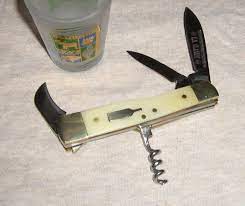 |
|
Rite Edge offers a laguiole style “picnic” knife featuring a large blade for slicing meat or bread and spine mounted corkscrew. The knives feature file work on the spine and the classic bee "lock" design but the lock is non-functioning and only decorative. Rite Edge uses 440 Stainless steel blade. The fit and finish and overall quality is "ok" for the price and the knife would fit in quite well for "a loaf bread, a jug of wine, and thou!" |
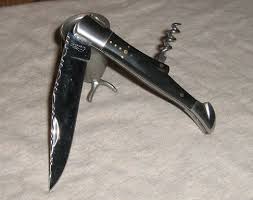 |
|
Several companies offer Lady’s Leg knife which is a close cousin to the bartender. Among the global importers are Schrade, Rough Rider and Frost; to name of few. This old pattern is making a bit of a comeback. Among American made knife makers, Northfield is one company that has offered a limited number of Lady Legs. Shown on the right is a 5 inch Rough Rider Lady's Leg in white smooth bone. |
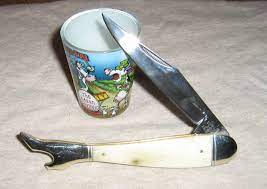 |
The Rough Rider Bartender knife is based on the Case Pattern 130. The knife has four blades including a spear master, pen, label cutter and corkscrew. Currently, Rough Rider offers the knife in three different styles. The knives are all part of the Support the Cause program; a charity of Smoky Mountain Knife Works which supports the University of Tennessee. Part of the proceeds of the sales from the Support the Cause programs goes to support research programs investigating treatment and cures for Heart Disease, Breast Cancer, and Prostate Cancer.
Obviously, several other companies offer knives with corkscrews and cap lifters but they are not marketed as a bartender or waiter knives. The most common of course are the various laguiole style bartender tools which retail for around $4 and are commonly found in grocery and liquor stores alike,
Collectors, however tend to shy away from current production bar tools and knives and concentrate on older knives. For the most part, the value of the bartender knife is often determined more by the advertisement than the the maker. The same can be said for antique bar-tools and corkscrews. While pattern and maker are important; the age, advertising, and condition are often seen more important. For instance a Bartender or corkscrew advertising Budweiser will be worth more than a bartender knife of similar quality and age advertising a lesser or unknown beer or a a local tavern.
Stanhopes are obviously the most desired and some, even in poor condition will fetch a high value. Of course if the image is still there, then the value skyrockets. Most collectors insist however on all blades being present and operational before they will consider a purchase. Broken knives tend to be bought and sold principally for parts.
|
A Camco Advertising Knife with Crushed Ice Scales. The caplifter in the tang of the knife. This was a very popular design. |
Camillus and Camco bartenders are sought after but do not demand a high dollar value. The Camcos were often given out as advertising knives or sold in liquor stores for under a dollar. Today they go for $5-15 if in good-excellent condition.
Ideal made numerous bartender key chain knives, primarily for the tourist trade. These knives are based on the B-13 bartender tool. They're junk but are often marked to sell for around $20. Occasionally you'll see one pop up for a around $5. Even at $5 you'll be disappointed by the quality.
In all, if you've been thinking about buying some interesting knives from a bygone age, or would like to collect ad knives, you may want to consider bartenders. Many are quite affordable so you can start out with a very small revenue risk. And if you find that is a pattern you really like, you can move on to some very high value and quite unique knives that appeal to not only knife collectors, but collectors of advertisements, corkscrews, church keys, and bar ware as well. Few other knives have as much appeal.